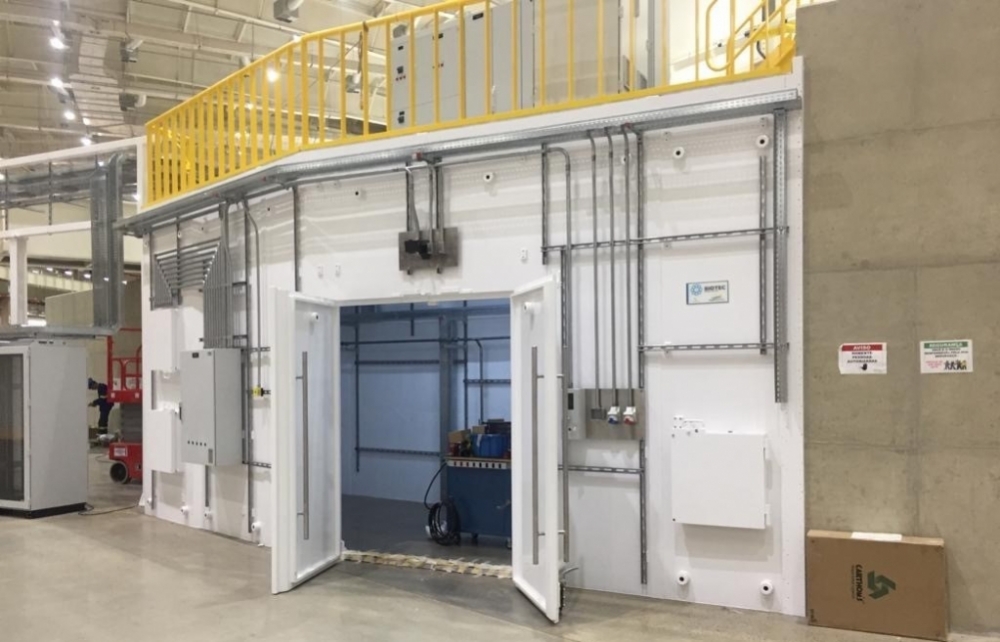

Radiation protection hutches are heavily shielded enclosures inside which the synchrotron light beam travels (photo: CNPEM)
The company responsible for supplying radiation protection hutches to Sirius wants to develop similar equipment for the healthcare industry.
The company responsible for supplying radiation protection hutches to Sirius wants to develop similar equipment for the healthcare industry.

Radiation protection hutches are heavily shielded enclosures inside which the synchrotron light beam travels (photo: CNPEM)
By Eduardo Geraque | FAPESP Innovative R&D – Biotec Solução Ambiental, headquartered in São José dos Campos, São Paulo State, is responsible for supplying special radiation protection enclosures called hutches to Sirius, Brazil’s new synchrotron light source. Installed at the National Energy and Materials Research Center (CNPEM) in Campinas, also in São Paulo State, Sirius is due to go live this year.
Until 2015, Biotec supplied cleanrooms to the pharmaceutical industry and the vivariums (laboratory animal facilities) of research centers. In that year, it won approval for its radiation hutch project in a second call for proposals to select suppliers of components for Sirius issued by FAPESP (through its Innovative Research in Small Business Program – PIPE) and FINEP, the Brazilian government’s innovation agency.
To address the associated challenges, Biotec’s team visited six European countries in 2015-16 (Spain, France, the United Kingdom, Switzerland, Germany and Sweden) to determine how metrology laboratories and radiation protection hutches in large-scale particle accelerators operate.
“The success of the hutch project came to depend on construction of the prototype. If it failed, the decision had been taken to import everything from Europe,” recalls Luciano Foianesi, a founding partner of Biotec.
Part of the team took up residence at CNPEM for a nine-month stay while working with the researchers responsible for the Sirius project on the testing of some 20 prototypes. The process culminated with the final choice of the type of radiation protection hutch to be installed on the EMA (Extreme Conditions Methods of Analysis) beamline, which will exploit different imaging modes to study materials under extreme temperatures, pressures and magnetic fields and will therefore require an intense photon flux.
Radiation protection hutches are heavily shielded enclosures inside which the synchrotron light beam travels. The wall thickness ranges from 6 mm to 127 mm depending on the conditions. The hutches prevent any leakage of energy from the light source aimed toward the material to be analyzed. “The radiation used in this research has to be very well protected. Otherwise, it would be a health hazard for Sirius researchers and staff. Leakage would also impair the efficiency of the analysis,” Foianesi explains.
Moisés Costa, Biotec’s head of engineering, adds: “The design required a robust computer to run the assembly of 37,000 components.” Five of the nine steel hutches commissioned by CNPEM have been delivered. The other four are currently being finalized.
Enhanced competitiveness
Development of the project for Sirius has made Biotec one of only six suppliers worldwide, and the only one in Brazil, that can deliver a complete radiation protection hutch with all the necessary mechanical and electrical utilities, including a heating, ventilation and air conditioning system (HVAC) with a thermal accuracy of ± 0.1 °C. Having responded to CNPEM’s technological challenge, Biotec began studying ways to leverage the knowledge acquired in the development of applications for the healthcare industry. It now plans to develop and sell a protection hutch for private and public hospitals for use in providing radiation treatment for cancer. It expects the hutch to be made of carbon steel and polyethylene and therefore to be lighter than conventional lead shielding to assure enhanced competitiveness.
Most diagnostic imaging enclosures used to diagnose cancer, for example, have walls that are 2 m thick and weigh 900 tons. Their fabrication takes two years, according to Costa. “That’s why they are always installed at street level or underground, and the area of the hospital concerned can’t be used for anything else ever again,” he says.
If the ongoing studies prove successful, the new hutch developed by Biotec will be designed to be dismantled and moved between areas of the hospital. “We also believe it will be possible to install it on a boat or ship, for use in remote parts of the Amazon, for example,” Costa says.
Company: Biotec
Site: grupofoianesi.com.br
Address: Avenida Doutor Altino Bondensan, Conjunto 2, Sala 2209, nº 500 / Eugênio de Mello / São José dos Campos (SP) / CEP 12.247-016 / Brazil
Tel.: +55 12 3939-1803
Contact: orcamento@grupofoianesi.com.br
Republish
The Agency FAPESP licenses news via Creative Commons (CC-BY-NC-ND) so that they can be republished free of charge and in a simple way by other digital or printed vehicles. Agência FAPESP must be credited as the source of the content being republished and the name of the reporter (if any) must be attributed. Using the HMTL button below allows compliance with these rules, detailed in Digital Republishing Policy FAPESP.





